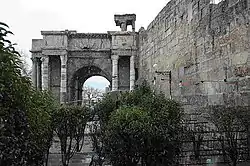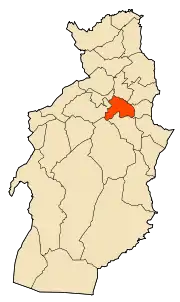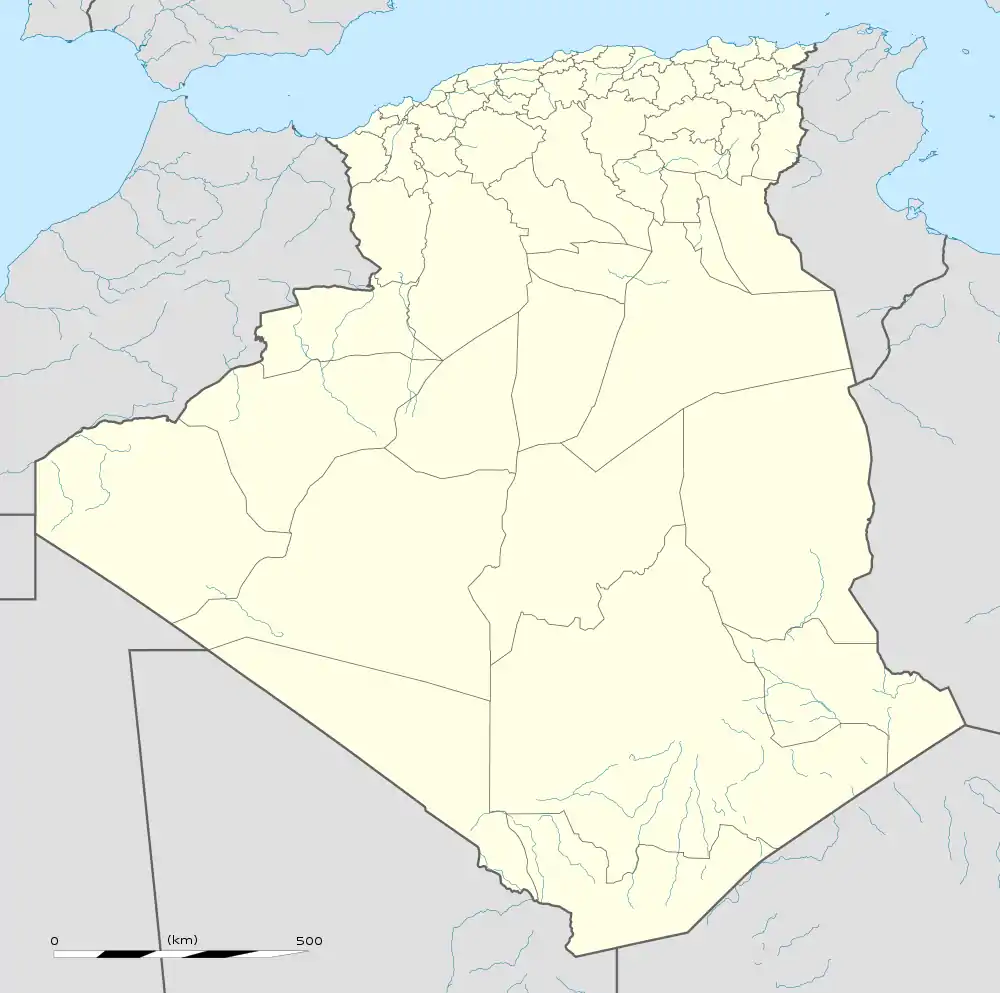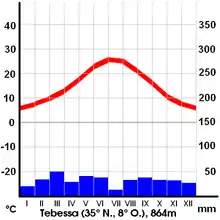Tébessa
Tébessa or Tebessa (Arabic: تبسة Tibissa, Tbessa or Tibesti), the classical Theveste, is the capital city of Tébessa Province region of northeastern Algeria. It hosts several historical landmarks, the most important one being the wall that surrounds the city and its gates. The city is also known for its traditional Algerian carpets. Tébessa was home to over 190,000 people in 2007.
Tebessa
تبسة | |
|---|---|
City | |
 Arch of Caracalla | |
 | |
 Tebessa | |
| Coordinates: 35°24′N 8°7′E | |
| Country | |
| Province | Tébessa Province |
| District | Tebessa |
| Area | |
| • Total | 14,227 km2 (5,493 sq mi) |
| Elevation | 858 m (2,815 ft) |
| Population (2008) | |
| • Total | 196,537 |
| • Density | 14/km2 (36/sq mi) |
| Time zone | UTC+1 (CET) |
| Climate | BSk |
Name
Tebessa, written Tébessa in French, was known to the ancient Greeks as Thebéstē (Θεβέστη) or Hekatompýlē (Ἑκατομπύλη, "Hundred Gates"). This was Latinized as Theveste.
History
In antiquity, Theveste formed part of the Roman empire.
After the establishment of the Roman Empire, the 3rd Augustan Legion was based in Theveste before being transferred to Lambaesis. Theveste later became a Roman colony, probably under Trajan in the early 2nd century. At the time of Trajan, it was a flourishing city with around 30,000 inhabitants. The ruins surviving in present-day Tebessa are very rich in ancient monuments, among them being a triumphal arch of Caracalla, a Roman temple, and a Christian basilica of the 4th century.
There is mention of a council held there by the Donatists. Among its saints were its bishop Lucius, who assisted at the 256 Council of Carthage and died as a martyr two years later; Maximilianus, martyred 12 March 295; and Crispina, martyred 5 December 304. Some of its other bishops are known: Romulus in 349; Urbicus in 411; Felix exiled by the Vandals in 484; Palladius mentioned in an inscription.
During the 4th and 5th century, Theveste was a hotbed of Manichaeism as well. In June 1918, a Latin codex of 26 leaves written by the Manichaeans was discovered in a cave near the city. A month later, Henri Omont found its other 13 initial leaves. The whole book is now known as the Tebessa codex and is kept in Cologne. It has been edited by Markus Stein.
Theveste was rebuilt by the patrician Solomon at the beginning of the reign of Justinian I. Solomon built his own tomb in Theveste, which still exists.
In the 7th century, the Muslim invasion reduced Theveste in importance but did not completely destroy it. In the 11th century, Banu Hilal, an Arab tribe originally living between the Nile and Red Sea, settled in Tripolitania, Tunisia, and Constantinois (the area around Constantine and Tebessa).
During the 16th century, the Ottoman Empire established a small garrison of Janissaries in Tebessa.
In 1851, the town was occupied by the French. It became the capital of its canton, then an arrondissement of the department of Constantine in Algeria. Later, its arrondissement was moved to the department of Bône. After Algerian independence, it became the capital of its own eponymous province.
Main sights
- Arch of Caracalla, a Roman triumphal arch (AD 214).
- Roman theater
- Temple of Minerva (early 3rd century AD), with walls decorated by mosaics.
- Amphitheatre (4th century AD)
- Remains of the basilica of St. Crispina (4th century AD), one of the biggest in Africa. It was partially destroyed by Berbers, and rebuilt in 535 by the Byzantine general Solomon. It has chapels, baptism urns, catacombs, and gardens, and a tesellated pavement.[1]
- Byzantine walls (6th century), popularly known as "Solomon's Walls" and flanked by thirteen square towers.
- Archaeological museum.
Climate

Tébessa has a semi-arid climate (Köppen climate classification BSk), with hot, fairly dry summers and mild, somewhat wetter winters.
| Climate data for Tébessa | |||||||||||||
|---|---|---|---|---|---|---|---|---|---|---|---|---|---|
| Month | Jan | Feb | Mar | Apr | May | Jun | Jul | Aug | Sep | Oct | Nov | Dec | Year |
| Record high °C (°F) | 24.0 (75.2) |
30.1 (86.2) |
32.0 (89.6) |
32.4 (90.3) |
40.6 (105.1) |
41.3 (106.3) |
42.5 (108.5) |
43.0 (109.4) |
40.0 (104.0) |
37.3 (99.1) |
31.0 (87.8) |
27.0 (80.6) |
43.0 (109.4) |
| Average high °C (°F) | 11.7 (53.1) |
13.5 (56.3) |
15.7 (60.3) |
19.2 (66.6) |
24.6 (76.3) |
30.7 (87.3) |
34.2 (93.6) |
33.3 (91.9) |
28.6 (83.5) |
22.6 (72.7) |
16.5 (61.7) |
12.9 (55.2) |
22.0 (71.5) |
| Daily mean °C (°F) | 6.4 (43.5) |
7.7 (45.9) |
9.5 (49.1) |
12.6 (54.7) |
17.4 (63.3) |
22.5 (72.5) |
25.4 (77.7) |
24.9 (76.8) |
21.2 (70.2) |
16.1 (61.0) |
10.7 (51.3) |
7.5 (45.5) |
15.2 (59.3) |
| Average low °C (°F) | 1.1 (34.0) |
1.9 (35.4) |
3.4 (38.1) |
5.9 (42.6) |
10.0 (50.0) |
14.2 (57.6) |
16.5 (61.7) |
16.4 (61.5) |
13.7 (56.7) |
9.5 (49.1) |
4.8 (40.6) |
2.0 (35.6) |
8.3 (46.9) |
| Record low °C (°F) | −8.0 (17.6) |
−6.6 (20.1) |
−6.0 (21.2) |
−4.0 (24.8) |
0.0 (32.0) |
3.0 (37.4) |
8.9 (48.0) |
8.0 (46.4) |
2.0 (35.6) |
−1.0 (30.2) |
−3.4 (25.9) |
−11.0 (12.2) |
−11.0 (12.2) |
| Average precipitation mm (inches) | 27.1 (1.07) |
30.3 (1.19) |
44.8 (1.76) |
30.6 (1.20) |
36.5 (1.44) |
31.2 (1.23) |
11.3 (0.44) |
25.1 (0.99) |
29.4 (1.16) |
23.6 (0.93) |
29.0 (1.14) |
23.6 (0.93) |
342.5 (13.48) |
| Average relative humidity (%) | 75.1 | 70.8 | 65.0 | 64.1 | 58.7 | 49.6 | 43.9 | 48.3 | 61.6 | 64.9 | 72.2 | 74.7 | 62.4 |
| Source 1: NOAA (1970–1990)[2] | |||||||||||||
| Source 2: climatebase.ru (extremes, humidity)[3] | |||||||||||||
Transportation
Tébessa is connected by road and rail with the other parts of both Algeria and Tunisia. It is served by Tébessa Airport for air transport.
References
Citations
- Chisholm, Hugh, ed. (1911). . Encyclopædia Britannica. 26 (11th ed.). Cambridge University Press. p. 487.
- "Climate Normals for Tebessa". Retrieved 11 February 2013.
- "Tebessa, Algeria". Climatebase.ru. Retrieved 11 February 2013.
Bibliography
- Stein (M.) (ed.) Manichaica Latina 3.1. Codex Thevestinus (Papyrologica Coloniensia volume 27/3.1.) Paderborn, Munich, Vienna and Zurich: Ferdinand Schöningh, 2004, Pp. xx + 328.
- Stein (M.) (ed.) Manichaica Latina 3.2. Codex Thevestinus (Papyrologica Coloniensia volume 27/3.2.) Paderborn, Munich, Vienna and Zurich: Ferdinand Schöningh, 2006, Pp. vi + 81, ills.
External links
 Media related to Tébessa at Wikimedia Commons
Media related to Tébessa at Wikimedia Commons- Official site of Tebessa
- Acta Maximiliani Martyris
- Page with photos of ancient ruins (in German)
 This article incorporates text from a publication now in the public domain: Herbermann, Charles, ed. (1913). "Theveste". Catholic Encyclopedia. New York: Robert Appleton Company.
This article incorporates text from a publication now in the public domain: Herbermann, Charles, ed. (1913). "Theveste". Catholic Encyclopedia. New York: Robert Appleton Company.- Chisholm, Hugh, ed. (1911). . Encyclopædia Britannica (11th ed.). Cambridge University Press.
.svg.png.webp)